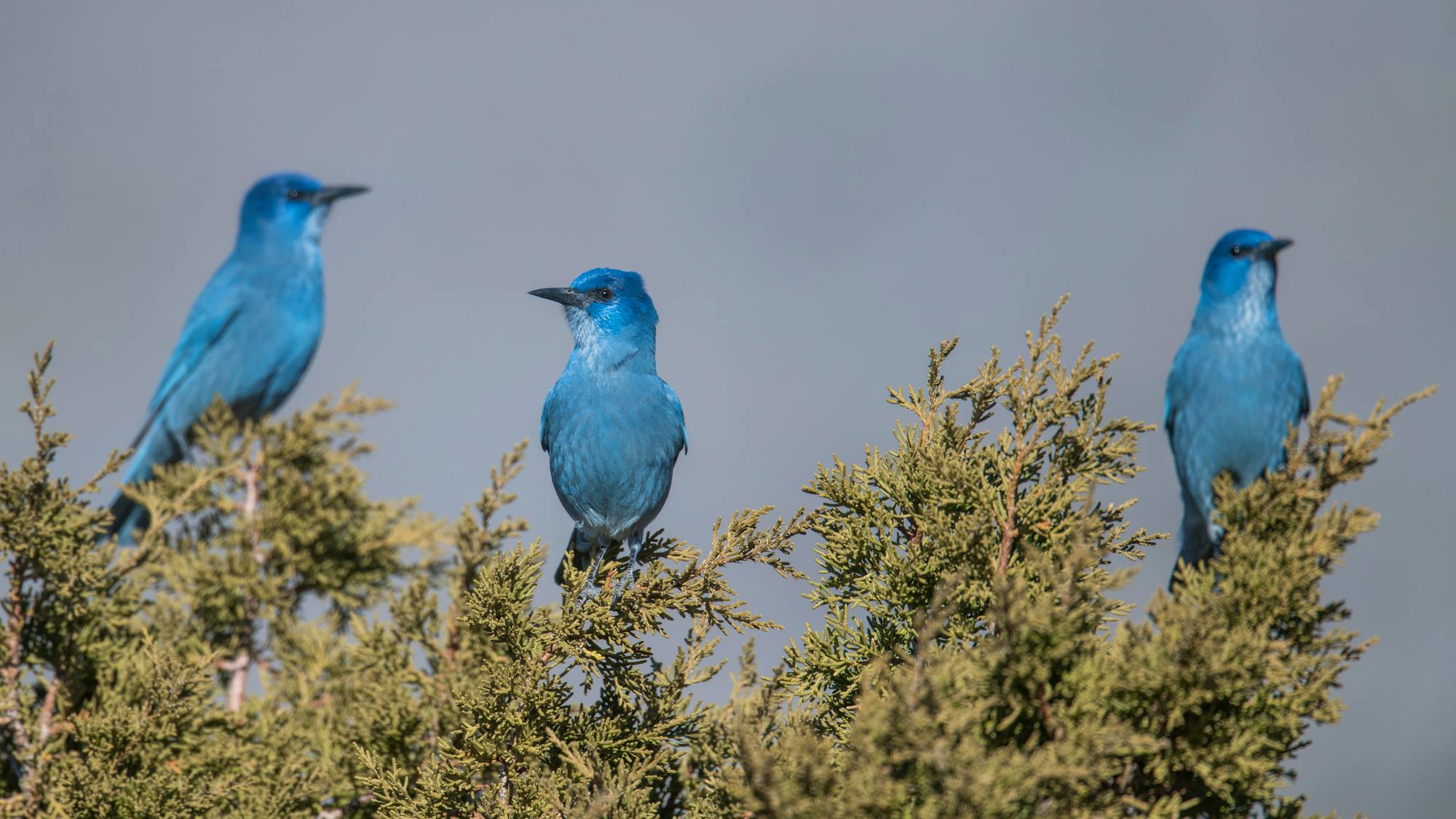Pinyon Jay Protections Help Other Woodland Animals Too
This blog was written by the Southwest Summer intern, May Ling Roberts.
Recognized as a highly social animal, pinyon jays can be observed in flocks of up to 500 individuals throughout the piñon-juniper woodland habitat they share with a diverse community of wildlife. They are a keystone species, supporting the ecosystem through countless services. While their bright blue feathers can be seen dotting tree lines across the Southwest, much of the largest pinyon jay population resides in New Mexico.
Many species benefit from pinyon jays, but none more so than the piñon pines, for which they are named. Just one of these little birds can hold up to 40 seeds at a time in their expandable esophagus, and throughout their lifetime cache thousands of piñon seeds, usually in the ground, for later consumption. Even though these intelligent birds can remember where seeds are stored, inevitably some are left behind and eventually grow into the next generation of piñon pine trees.
In recent years, however, climate related stressors and other factors have contributed to a decrease in piñon seed production, affecting food availability for woodland wildlife. By protecting pinyon jays we can support the whole community, from plants to animals, because a healthy pinyon jay population means a healthy ecosystem.
Meet some of the woodland animals that thrive when we protect the beloved pinyon jay.
Juniper Titmouse
The playful juniper titmouse has a grey tufted head shaped like a mohawk and is often seen hopping from perch to perch and even hanging upside-down on branches. These birds are closely related to chickadees and are a piñon-juniper specialist.
With almost half of its global population located in New Mexico, this bird has a limited habitat range and relatively small population size.
Woodhouse’s Scrub-Jay
The Woodhouse’s scrub-jay has a symbiotic relationship with mule deer. They stand on the backs of deer for a nutritious meal of ticks and other parasites, freeing the deer from irritation and potential disease.
These scrub-jays make beautifully crafted nests, woven with small twigs and lined with cushy fibers. They prefer scrub and bushy areas with plentiful pine seeds and juniper berries — their favorite food — which the piñon-juniper woodlands historically offered. Despite their cleverness, this bird’s population is declining rapidly in some areas, including in New Mexico due to loss of habitat and food caused by pinyon pine die-offs from bark beetle infestation and drought. More research is needed to determine recent declines throughout the southwest.
Pinyon Mouse
The pinyon mouse is incredibly endearing with big ears for hearing predators and even bigger eyes for night vision. This nocturnal species is considered highly arboreal, meaning they live in trees and benefit from the protection, seeds, fruits and nuts provided by the forest.
Pinyon mice specifically depend on piñon-juniper for habitat. They are most often seen in rocky areas with juniper or piñon pine trees and are found across the Southwest.
Oscura Mountains Colorado Chipmunk
Like the pinyon mouse, this chipmunk is an endemic species and an old-growth specialist. They are often observed scurrying around the woodland understory foraging for piñon seeds and juniper berries. Older trees have been shown to produce more cones containing important food for wildlife. The Oscura Mountains Colorado chipmunk is picky about choosing a home, requiring old-growth conditions with forests at least 400 years old.
As tree cutting in piñon-juniper woodlands becomes more prevalent, this chipmunks’ range is shrinking and its population faces increased threats. Prioritizing old-growth habitat is important for the survival of this charismatic species and many others like it.
Penasco Least Chipmunk
Penasco least chipmunks are becoming a rare species in New Mexico. They are endemic to the high-elevation juniper woodlands and ponderosa pine forests of the Sacramento Mountains.
These chipmunks prefer open areas with thin densities of trees for foraging and burrowing, but this habitat suffers from climate change impacts, livestock overgrazing and more. Since this species has a very limited habitat range and is predicted to endure climate related stressors, the Penasco least chipmunk is a candidate for listing under the U.S. Endangered Species Act.
Roundtail Horned Lizard
The roundtail horned lizard uses camouflage to evade predation and is often mistaken for a small rock or patch of soil by predators and people. This lizard is round and flat, sometimes hunching its body to appear more rock-like.
They are found in open juniper woodlands and will bury themselves in soil to keep cool or hide. The roundtail horned lizard is a species of high concern. They are vulnerable to collection for the pet trade, vehicle collisions and habitat loss.
Help Pinyon Jays and Preserve Piñon-Juniper Woodlands
To support pinyon jays and conserve piñon-juniper woodlands, advocate for pinyon jay listing under the ESA. Gaining status as a federally endangered species will grant the pinyon jay further protection, while also helping the other associated woodland animals too.
If you are a visitor or resident of New Mexico, save the seeds for the birds! Refrain from collecting piñon pine seeds and if a pinyon jay is observed caching seeds from a fruiting piñon pine, ensure that this tree is not threatened by anthropogenic means.
Learn more about Defenders’ pinyon jay conservation work and, if you are able, support organizations like Defenders that are working to conserve pinyon jays and other wildlife in the piñon-juniper woodlands.













